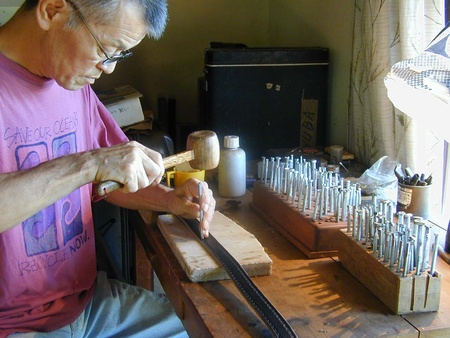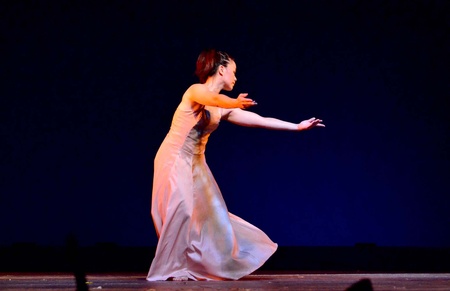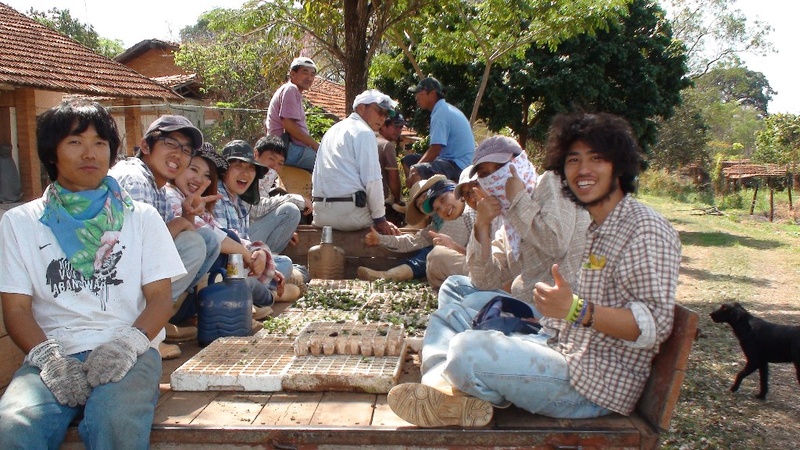EDITOR’S NOTES: In the 1930s, a group of Japanese immigrants settled in an area of Brazil called Aliança with the intention of establishing a colony. Among them were Isamu Yuba and his family. Yuba, along with some friends, later went on to purchase land in the area. They had a vision of establishing their own self-sustaining farming community with the values of “cultivation, prayer, and art” at the forefront. Their vision eventually became the Yuba Community.
Today, the Yuba Community still follows Isamu Yuba’s original vision. It is a community that is distinct from the rest of the Brazilian Nikkei community. Individual members bear responsibilities for maintaining the community, such as farming, preparing meals, etc., and participating in traditional Japanese culture as well as a variety of art forms is considered important. In the following article, we present the stories of two people who live or have lived in the Yuba Community.
* * * * *
A slightly different reality, not entirely Brazilian or Japanese, exists in the town of Mirandópolis, about 600 km (375 miles) from São Paulo. There, the unique, self-sustaining Yuba Community, composed of Japanese immigrants and Japanese–Brazilians, strives to preserve aspects of traditional Japanese culture.
A new culture
Born in the town of Hokuto, Yamanashi Prefecture, Japan, 72-year-old Masakatsu Yazaki has lived in Yuba since 1963. “At first, I came here only to visit the community; I had no intention of settling in Brazil,” he says. Once he made the move, Yazaki invited his mother and father to join him. His sister and brother also came out to visit.

Currently, Yazaki dedicates himself to music. Self-taught, he plays the piano, teaches classes, and performs as a conductor at the community Christmas concert. He also repairs footwear—in Japan, he had studied leather handicraft and footwear manufacturing techniques. In his free time, he enjoys reading, watching movies, and writing haiku (or haikai).
Yazaki’s favorite thing about life in Yuba is the fact that they have 90 percent self-sufficiency in food production, and the freedom for each person to do what they wish.
Although Yuba is one of the few places in Brazil where the preservation of Japanese culture is prioritized, adjustments are made to suit local needs, just as they are in the cities. “It’s a place where a new culture is being born,” said Yazaki. “The language, food, and customs of the Japanese people have merged with the conditions particular to this area.”
The passing of time results in major changes. Yuba is building a food processing factory to accommodate its expanding population. Currently, Yuba consists of 28 homes housing a total of 56 people.
Many of the changes are being made by the new generations—or, at least, they’ve been placed in charge of the task. Yazaki has a very positive outlook on the community leaders. “Yuba’s youth carry within themselves the spirit of the traditional culture, cultivated throughout our community’s 80-year trajectory, and that has turned them into dedicated young people, of strong character and full of vitality,” he reflects.
“Art must be present on a daily basis”
Art was essential to Isamu Yuba’s vision; he felt it was important to bring in immigrant artists to strengthen the Yuba colony. That’s how the family of Aya Ohara, 43, came to settle there, following an invitation by the founder himself.
Aya’s father, Hisao Ohara, was a sculptor. Her mother, Akiko Ohara, is a ballerina and choreographer, and the founder of the Yuba Ballet. Akiko’s arrival in 1961 brought the construction of the Teatro Yuba and a new era of cultural development in the community.

Born in Yuba, Aya Ohara’s daily routine growing up was quite hectic. While attending a public school in the Aliança neighborhood, she took weekly lessons in Japanese language, ballet, choir singing, and drawing in Yuba. Until the age of 10, she helped to prepare meals for the Yuba community, which at the time had 80 members. At the age of 11, she began working in the fields with her older brothers.
In Yuba, youths and adults work in the fields while older women and mothers with small children are responsible for tending the vegetable gardens and providing cafeteria services. Each person also has the freedom to choose other responsibilities, such as taking care of Yuba’s museum collection, teaching dance classes, etc.
“As a child, I enjoyed doing everything that involved groups—theater rehearsals, party arrangements, and the like,” says Ohara. In her spare time, she enjoyed drawing, doing embroidery, and playing outdoors with friends.
Since the life of a Yubense is unlike that of other Nikkei living in the cities, the community’s sense of identity is also different. “I consider myself Brazilian, with a strong cultural influence from the Yuba Community,” Ohara asserts. “I’m different from the Japanese Brazilians who live elsewhere in Brazil, but I’m also different from the Japanese from Japan.”
When it comes to valuable lessons, everything has been relevant. “It’s a school of life, love, and the collective. It’s like being in a large family,” Ohara reflects. “Happiness, sadness, achievements—it’s all very intense.”
Ohara describes the culture of the Yuba Community as a “hybrid Japanese–Brazilian culture.” The artistic pursuits and the work in the fields establish a constant social dialogue, attracting people from all kinds of professional backgrounds and allowing for the exchange of knowledge and ideas.
There are many Japanese traditions preserved in the community’s day-to-day activities, which those who live or have lived in Yuba want to pass on to the younger generations. Among these are: mochitsuki (ceremonial mochi pounding to welcome a new year), Koinobori (carp streamers to celebrate Boys’ Day), Hinamatsuri (Girls’ Day), haiku writing, and traditional dance (such as bon odori). The Yubenses have also kept various recipes inherited from their ancestors, as well as the Christmas show that has been staged since the founding of the Yuba Community in 1935.
Like Yazaki, Ohara is greatly interested in the arts, especially ballet, which she began practicing shortly after she learned to walk. She believes that she may have been interested in ballet while still in her mother’s womb.
It was through ballet that, at age 15, Ohara had the experience of studying in Japan for five years. “It was a thrill to be exposed to a world that I’d always known only from books and my imagination,” she says. “I had to push myself very hard to stay on top of things. After my training, I joined the theater group Shiki, which is highly regarded in Japan. That was one of the most enriching experiences of my artistic career.”
Following this immersion in Japanese society, Ohara decided to move to São Paulo to seek out new experiences. She remains in touch with Yuba, however. Between 2009 and 2013, she coordinated Ponto de Cultura: Cultivar a Arte (Culture Point: Cultivating Art), an initiative of the a federal government in partnership with the state government. Its goal was to support entities that were developing some type of artistic activity in their communities—like the Yuba Community Association.
The purpose of the Yuba Community Association was to strengthen the community through exchanges and experiences geared toward generating insights, fostering new artistic creations, and mentoring younger generations while maintaining the community’s core values: the arts, cultivation of the land, and prayer. The project also aimed to expand the scope of Yuba’s cultural activities so that surrounding communities could enjoy its activities, thus sharing Yuba’s legacy with people outside of Yuba.
Ohara says all of these experiences have been fundamental to her understanding of the complexity of Brazil, particularly in terms of the country’s racial dynamics and the question of identity there.
It seems that anyone who becomes a Yubense creates a strong bond with art. Community founder Isamu Yuba’s philosophy, as seen in the below quotes, relates culture to one’s roots, believing that it helps to create a unique identity.
The building of a nucleus here in Brazil, where immigrants can achieve social integration alongside their traditions.
In order to reach this goal, first of all we need to set cultural roots by means of sturdy principles.
Therefore, art must be present on a daily basis to provide constant, vivid imagination and the strength of unity.
—Isamu Yuba and comrades
© 2016 Tatiana Maebuchi






